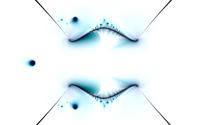Babbage Functions, Involutions
A Babbage Function f(x) solves the functional equation f(f(x)) = x.Examples are: f(x) = -x; f(x) = 1/x; f(x) = sqrt(1 - x^2).
Repeatedly using a Babbage Function in an iteration has the effect,
that every second value is x (or in our case c).
E.g.: c,-c,c,-c,c,-c
If f(x) is a Babbage Function, h(x) and the inverse of h: hInv(x) are injective, then g(x) = h( f( hInv(x) ) )
is a Babbage Function, too. (g(x) is the topological conjugate of f(x)).
E.g.: f(x) = 1 - x, h(x) = exp(x), hInv(x) = log(x): g(x) = exp(1 - log(x))
It is not necessary to use Babbage Functions to have repeated periodic values of c,
while disturbing c, but it is very convenient.








